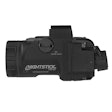A few days back I was scrolling through a rangemaster's forum on the Web, and I read that the conventional wisdom these days among law enforcement firearms decision makers is that other than for precision rifle use (They have a hard time with the word "sniper.") the .308 Winchester cartridge is too heavy a caliber for everyday carry.
What that really means is that the people who decide what guns we carry in the field think that only snipers should have .30-caliber weapons readily available.
Granted, .30-caliber long guns have a limited and specialized place in law enforcement. But that doesn't mean they shouldn't be in the trunks of our patrol cars. After all, the folks in the patrol cars are usually the ones that run across those limited and specialized situations in the first place.
Just as the conventional thinking on containment and waiting for the department's tactical team to respond has evolved into immediate action when necessary as in an active-shooter situation, so has the conventional thinking on patrol rifle caliber. More departments across the country are allowing patrol officers to carry a heavy-caliber long gun. The deployment of these guns varies from full- and part-time tactical team members to the rank-and-file patrol officer.
Smaller rural departments were some of the first to recognize the benefit of a .308 Winchester patrol rifle. The reason for this is easily understood. When you keep the peace in ranch or farm country, a long-range shot can be critical to your survival and to public safety.
And now some urban departments are starting to field .308 caliber patrol rifles. What this shows is that some right-thinking police administrators in urban departments have realized that their officers need a heavy-caliber, long-range option, even though touching off a .308 Winchester round in a built-up urban or suburban community becomes problematic.
Officer or citizen rescues involving a barricaded and actively shooting suspect are one area where the .308 Winchester round used for suppression fire is hard to match. In a semi-automatic configuration with a 20-round magazine, there are few systems available that could be better suited to such a task.
A Proud History
And that brings us to the gun of the hour, a weapon system that has roots back to Gen. George Washington himself. No, we're not talking about an officer pouring black powder down the muzzle of an issued flintlock rifle, although that would be both heavy caliber and long range. The historical connection here is the manufacturer, one of the oldest and proudest names in American firearms production: Springfield Arms.
George Washington designated Springfield Armory as the country's first arsenal in 1794. The original Springfield Armory served the country through wars and foreign conflicts for almost 175 years before it closed in 1968. In 1974, Robert Reese acquired the Springfield Armory name and began producing match-grade M1A rifles for the civilian and military markets. The company, now located in Geneseo, Ill., produces superior-quality M1A rifles in .308 Winchester caliber. Its newest .308 model is the M1A SOCOM 16.
Originally developed in caliber .30-06 by weapons designer John Garand, the M1 .30 Caliber Rifle became the standard long arm of the U.S. Army. It was adopted in 1932 and entered service in 1936.
On World War II battlefields, the M1 Garand proved to be such an excellent weapon that enemy soldiers would often use captured M1s in combat. After the war, the newly formed North Atlantic Treaty Organization (NATO) decided that its multinational troops should use a single rifle cartridge and, considering their experiences both good and bad with the weapon, the European armies expressed admiration for the M1 and its .30 caliber cartridge. So, the U.S. offered the T65 cartridge, which was a shortened .30-06 cartridge. The benefit was lower recoil and reduced carry weight.
The U.S. pressed NATO for acceptance of the .30 caliber cartridge, and it was finally accepted as the 7.62x51mm NATO. We know it in the civilian and police markets as the .308 Winchester.
The M14
The original M1 Garand was modified to chamber the new 7.62x51mm cartridge along with other improvements and re-designated the M14 Battle Rifle. But the M14 also differed from the M1 in a few significant ways.
Key among these improvements was a detachable box magazine, a much better system than the M1 Garand's en bloc clip loading device. The M14 also included a selector switch that let the shooter choose semi- or full-automatic fire. Other modifications were the result of bulking up the rifle to make it capable of absorbing the repeated heavy recoil of its gas system.
The M14 was accepted for service in 1957. Shortly after it was accepted, the military found that the majority of soldiers had trouble controlling the gun in full-auto mode, and the selector levers were pinned down to allow semi-automatic fire only.[PAGEBREAK]
A Great Update
The Springfield Armory M1A SOCOM 16, like the M14, is a magazine-fed, rotating-bolt, gas-operated, air-cooled, semi-automatic, shoulder-fired rifle chambered in .308, aka 7.62x51mm NATO. It also has some unique features. For example, the SOCOM's barrel has been shortened to 16.25 inches, the minimum length allowed under federal law.
Just like its long line of ancestors, the SOCOM 16 was created for the military. A bunch of special ops guys who really know their guns thought it might be a good thing if they had another tool in their close quarter battle kit.
So their weapons development team worked with Springfield Armory to come up with just that tool, the M1A SOCOM, a designation that stands for "Special Operations Command. It is unknown if the special ops guys actually deployed the SOCOM; they're a somewhat tight-lipped bunch about that kind of thing.
Development of a weapon that met special ops' demands for a short-barreled, heavy-caliber carbine was more difficult than you might imagine. One of the biggest hurdles was fine-tuning the gas operating system of the SOCOM to ensure reliable function.
A similar attempt to change the M1 to gas operation was attempted in 1944. Sometimes mistakenly called the "Tanker's Garand," the M1E5 or T26 was cut down to 18 inches and fitted with a folding stock.
Unfortunately, the weapon proved unreliable because the military could not come up with a reliable fix for the gas operating system. Additionally, the muzzle flash and jump, not to mention a problem with unburned powder, made the T26 a terrible soldier's rifle. The project was shelved.
Fortunately, Springfield Armory has solved those problems with the SOCOM. The change from the more powerful .30-06 cartridge to the .308 Winchester helped. Also more modern machining and manufacturing techniques along with better and more efficient propellant powders played a large role in the success of the project. In addition, Springfield Armory came up with a proprietary muzzle break that is one of the most efficient ever seen on a short-barreled, heavy-caliber carbine.
Nicely Appointed
Military weapons are rarely fancy and, for obvious reasons, they aren't big on gadgets. The SOCOM is no exception.
However, that doesn't mean that this rifle is without its charms. It's extremely well built, and it sports some functional features that will help any shooter adjust the weapon to match his or her needs.
The SOCOM's barrel is chrome-moly 16.25 inches in length with one turn in 11 inches right-hand twist rifling with six grooves. It will easily launch any weight .308 Winchester round accurately out to 300 meters.
Rear sights on the SOCOM are enlarged military aperture-type sights with click adjustments for both windage and elevation. The front sight is a tritium post manufactured by XS Sights. Some earlier versions were hooded and some now have two ears or wings.
Augmenting the iron sights, the SOCOM has a 1913 Mil-Spec rail on the forward handguard for mounting optics. One-to-One optics like the EOTech 512 or Trijicon's ACOG and optical magnification sights mount easily and provide speedy target acquisition.
The two-stage military trigger breaks crisply at between five and six pounds, and there is little if any creep. The safety is traditional for the M1A mounted at the front of the trigger guard. Push it forward and it's ready to go.
One of the things the special ops guys wanted from the new M1A was less weight than the standard M14. Springfield cut the mass of the M1A SOCOM by reducing the length of the barrel and replacing the standard M14 stock with a fiberglass stock. The combination makes the M1A SOCOM 16 a lot easier to hump around than a standard M1A. It would be a stretch to call the SOCOM 16 lightweight, but this 8.9-pound gun is lighter than the original 9.5-pound Garand our dads and granddads carried or the 12-pound M25 sniper version.
Loud and Mean
I first saw the SOCOM a few months back at Springfield Armory's Writer's Conference in Mesa, Ariz. And I've seen it shot better than probably anyone ever will again. Four-time world champion and Springfield Armory promotional shooter Rob Leatham put on a demonstration with the gun that made me glad he is on our side.
Once I was able to shoot the SOCOM, I found it to be very loud but extremely accurate. The efficiency of the muzzle break was amazing. Recoil was little more than shooting an AR-15 chambered in the diminutive .223 Remington. There was no perceptible muzzle rise, which you would normally expect in a short gun of this caliber, and followup shots were easy, rapid, and accurate.
I wouldn't want to use the M1A SOCOM as an entry gun because of the noise and directed muzzle blast. Or I should say I would not want to be one of the tactical team members standing next to the shooter during an entry. But as a heavy-duty patrol rifle, this gun is outstanding.
The M1A SOCOM can supply well-directed heavy fire from an easy-to-use, cop-friendly platform. It provides fast target acquisition and maneuverability, especially when coupled with good optics. And because of its short barrel, the SOCOM is just as effective close in as it is at distances well beyond normal law enforcement engagement ranges.
There are drawbacks to the 16.25-inch barrel, namely it's really loud. But recoil from the M1A SOCOM is relatively minimal for such a short and lightweight carbine in .308 caliber. And the barrel length also has its pluses. The SOCOM fits easily in an AR-15 carry bag for storage in a patrol car's trunk. Magazines and a tremendous selection of ammunition types are readily available.
If you or your agency are looking for a patrol rifle for those "limited and specialized situations" we all know never happen to patrol cops, take the M1A SOCOM for a test drive. It provides everything that you might need from a heavy-caliber patrol rifle.
Springfield Armory
M1A SOCOM 16
Caliber: .308 Winchester
Capacity: 10-round box magazine
Mechanism: Rotating-bolt, gas-operated,
air-cooled, semi-auto, magazine-fed rifle
Barrel Length: 16.25 inches
Overall Length: 37.25 inches
Weight: 8.9 pounds
Rear Sights: Military aperture with windage and
elevation adjustment
Front Sights: Tritium posts
Trigger Pull: 5 to 6 pounds
Price: $1,727
www.springfieldarmory.com
Sgt. Dave Douglas is the rangemaster of the San Diego Police Department, a veteran law enforcement officer, and a Police contributing editor.















